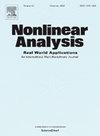Global solvability of a model for tuberculosis granuloma formation
IF 1.8
3区 数学
Q1 MATHEMATICS, APPLIED
引用次数: 0
Abstract
We discuss a nonlinear system of partial differential equations modelling the formation of granuloma during tuberculosis infections and prove the global solvability of the homogeneous Neumann problem for in bounded domains in the classical and weak sense in the two- and three-dimensional setting, respectively. In order to derive suitable a priori estimates, we study the evolution of the well-known energy functional for the chemotaxis–consumption system both for the - and the -subsystem. A key challenge compared to “pure” consumption systems consists of overcoming the difficulties raised by the additional, in part positive, terms in the second and third equations. This is inter alia achieved by utilizing a dissipative term of the (quasi-)energy functional, which may just be discarded in simpler consumption systems.
结核肉芽肿形成模型的全局可解性
讨论了模拟结核感染过程中肉芽肿形成的非线性偏微分方程组,证明了在经典和弱三维条件下,ut=DuΔu - χu∇⋅(u∇v) - γuuv - δuu+βu,vt=DvΔv+ρvv - γvuv+μvw,wt=DwΔw+γwuv - αwwz - μww,zt=DzΔz - χz∇⋅(z∇w)+αzf(w)z - δzzin有界区域的齐次Neumann问题的全局可解性。为了得到合适的先验估计,我们研究了(u,v)-和(z,w)-子系统的趋化消耗系统的能量泛函的演化。与“纯”消费系统相比,一个关键的挑战是克服第二和第三个方程中额外的(部分是积极的)项所带来的困难。除其他外,这是通过利用(准)能量泛函的耗散项来实现的,这可能只是在更简单的消耗系统中被丢弃。
本文章由计算机程序翻译,如有差异,请以英文原文为准。
求助全文
约1分钟内获得全文
求助全文
来源期刊
CiteScore
3.80
自引率
5.00%
发文量
176
审稿时长
59 days
期刊介绍:
Nonlinear Analysis: Real World Applications welcomes all research articles of the highest quality with special emphasis on applying techniques of nonlinear analysis to model and to treat nonlinear phenomena with which nature confronts us. Coverage of applications includes any branch of science and technology such as solid and fluid mechanics, material science, mathematical biology and chemistry, control theory, and inverse problems.
The aim of Nonlinear Analysis: Real World Applications is to publish articles which are predominantly devoted to employing methods and techniques from analysis, including partial differential equations, functional analysis, dynamical systems and evolution equations, calculus of variations, and bifurcations theory.

 求助内容:
求助内容: 应助结果提醒方式:
应助结果提醒方式:


